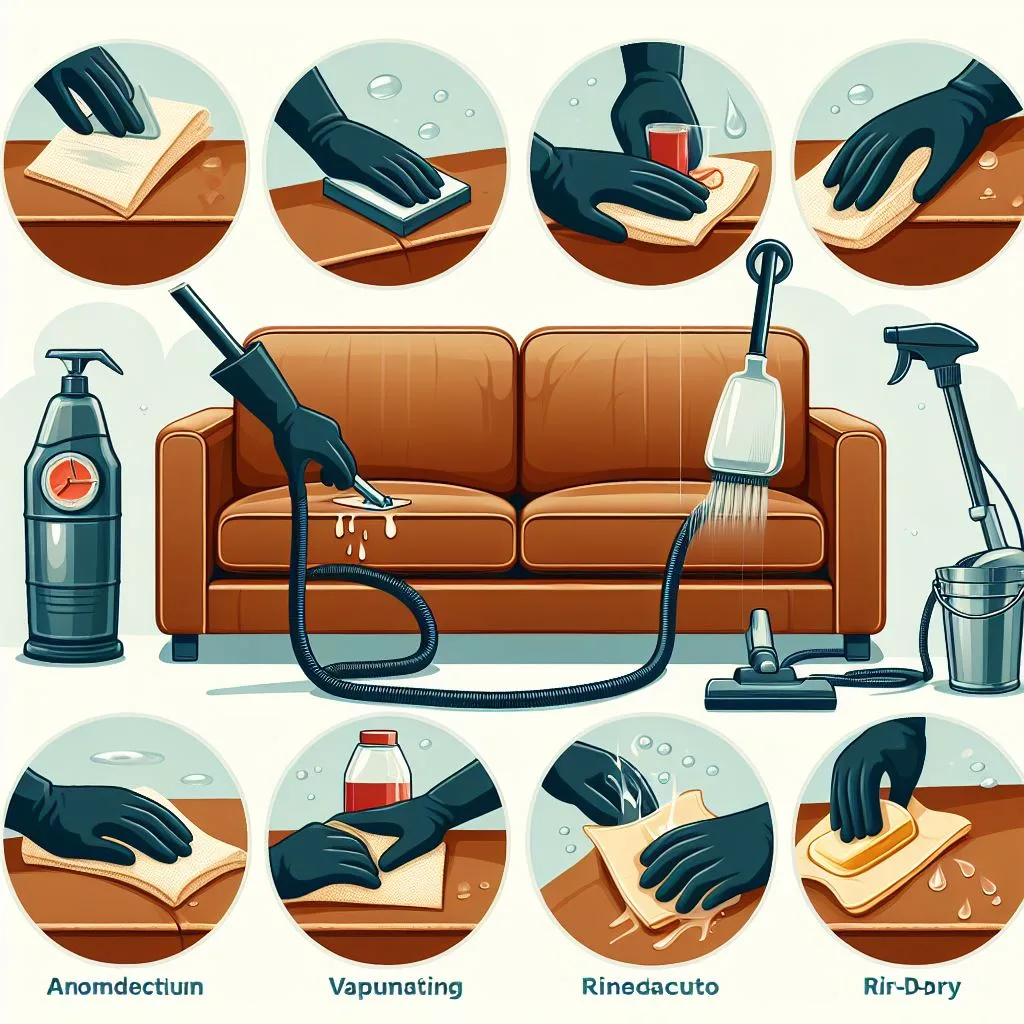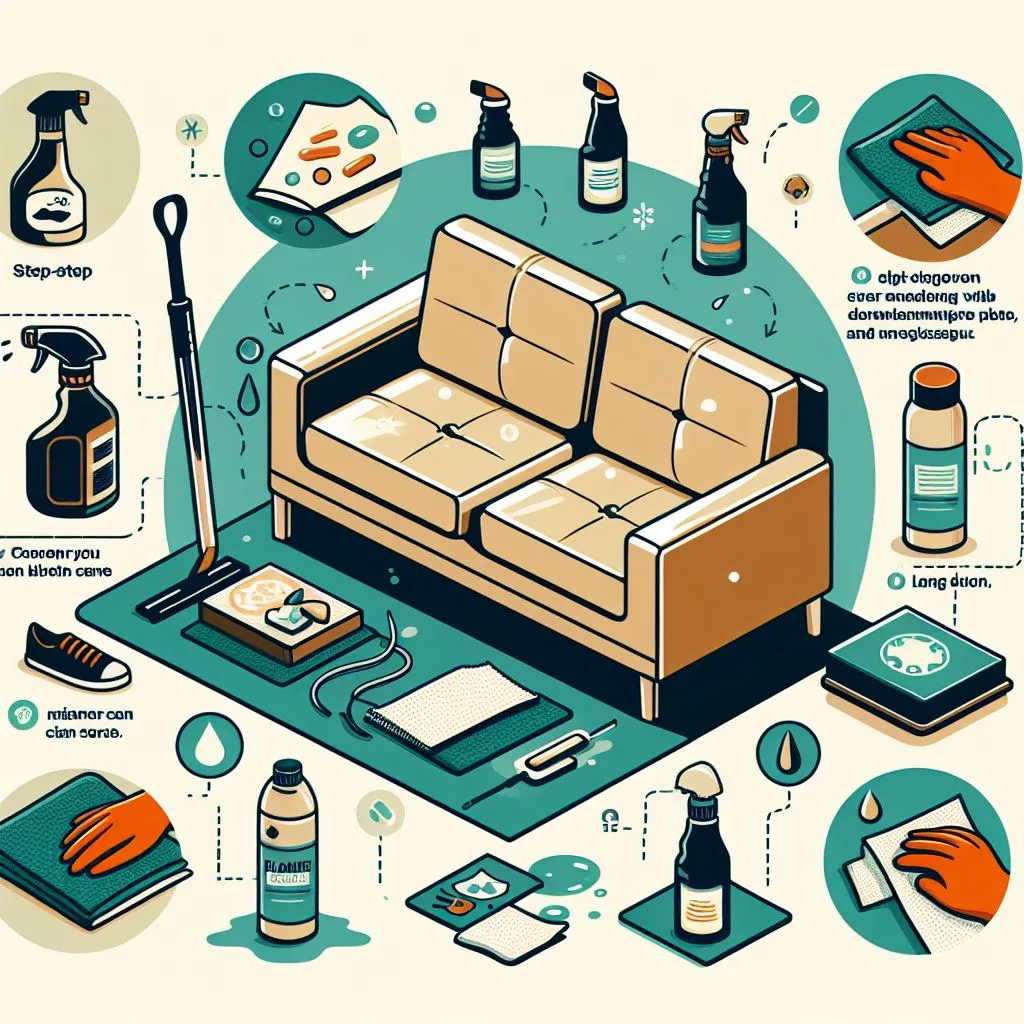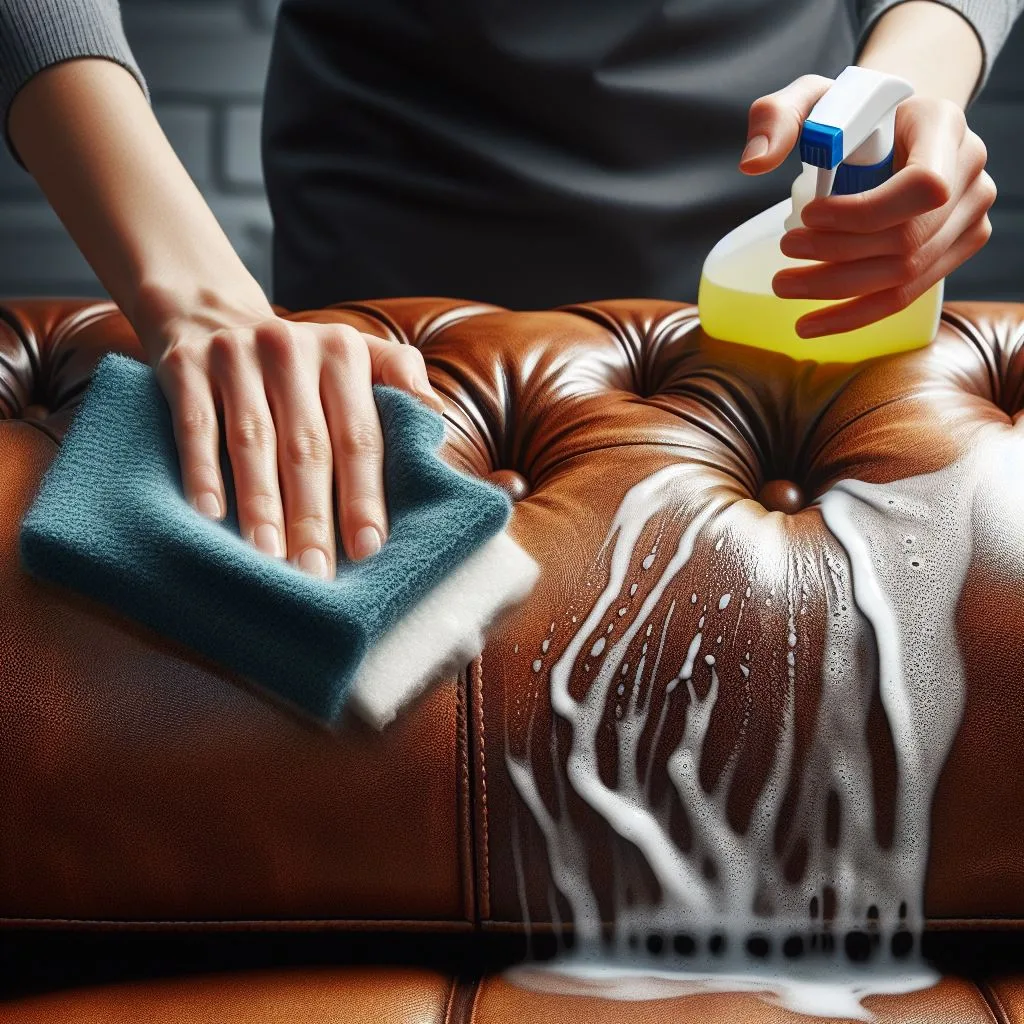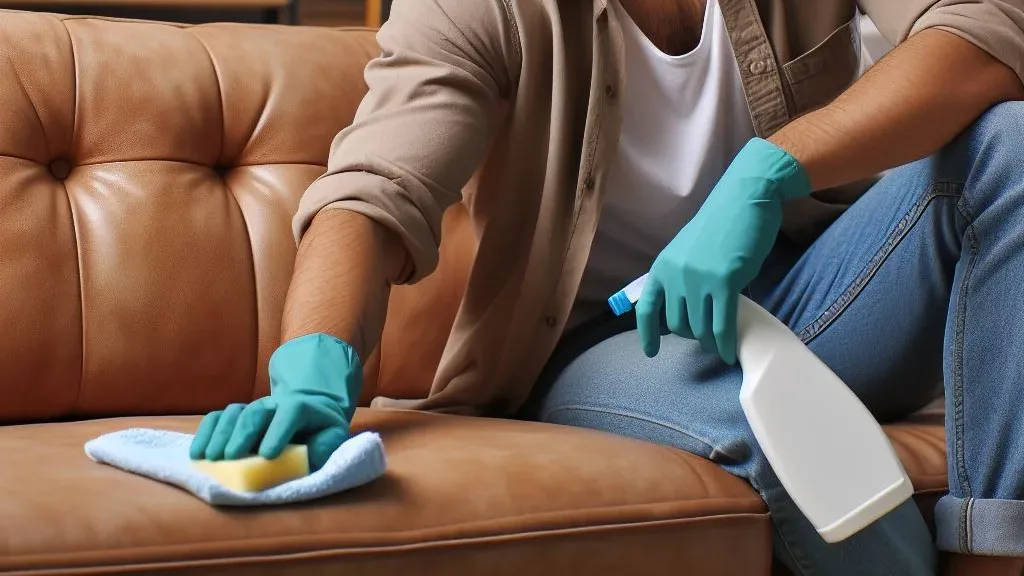A pleather couch is a stylish and affordable furniture option that can add a touch of sophistication to any living space. However, to ensure its longevity and pristine appearance, regular cleaning and maintenance are crucial. In this comprehensive guide “How to Clean Pleather Couch”, we’ll delve into the specifics of cleaning a pleather couch, including general maintenance tips, deep cleaning methods, stain removal techniques, special care instructions, and tips for maintaining durability.
Understanding Pleather
What is Pleather?
Pleather, short for “plastic leather,” is a synthetic material designed to mimic the look and feel of genuine leather. It is commonly used in furniture upholstery due to its durability, affordability, and versatility. Unlike genuine leather, pleather is easier to clean and maintain, making it a popular choice for households with pets or children.
Benefits of Pleather Furniture
- Affordability: Pleather furniture is often more budget-friendly than genuine leather.
- Durability: It is resistant to scratches, stains, and fading, making it ideal for high-traffic areas.
- Easy Maintenance: Pleather can be easily cleaned with mild soap and water, requiring minimal upkeep compared to genuine leather.
- Versatility: Pleather comes in a variety of colors and textures, allowing for versatile design options.
Differences Between Pleather and Genuine Leather
While pleather and genuine leather share a similar appearance, there are key differences to consider:
- Material Composition: Pleather is made from synthetic materials such as polyurethane (PU) or polyvinyl chloride (PVC), while genuine leather is derived from animal hides.
- Durability: Genuine leather is generally more durable and long-lasting than pleather, but it requires more maintenance to preserve its quality.
- Cost: Genuine leather tends to be more expensive than pleather due to its natural sourcing and production process.
Common Misconceptions about Pleather
- Lack of Breathability: While genuine leather is known for its breathability, pleather can also offer ventilation when designed with perforations or breathable fabrics.
- Environmental Impact: Some people assume that pleather is less environmentally friendly than genuine leather due to its synthetic nature. However, advancements in eco-friendly materials have made sustainable pleather options available.
General Maintenance Tips How to Clean Pleather Couch
Taking care of your pleather couch on a daily basis can significantly extend its lifespan and maintain its appearance. Here are some general maintenance tips to keep in mind:
- Daily Care Routine: Dust and vacuum your pleather couch regularly to remove surface dirt and debris. Use a soft brush attachment to prevent scratches.
- Wiping Down with a Damp Cloth: For routine cleaning, use a damp cloth to wipe down the surface of the pleather. Avoid using harsh chemicals or abrasive cleaners, as they can damage the material.
- Preventative Measures: To prevent damage, consider using covers or throws on your pleather couch, especially if you have pets or young children. Additionally, keep your couch away from direct sunlight and heat sources, as prolonged exposure can cause fading and drying out of the material. Avoid placing sharp objects on the couch to prevent scratches.

How to Clean Pleather Couch: Deep Cleaning Methods
While regular maintenance can keep your pleather couch looking clean, occasional deep cleaning is necessary to remove embedded dirt and stains. Here’s How to Clean Pleather Couch effectively:
Spot Cleaning:
1. Identifying Stains
Before cleaning a stain, it’s important to identify its type. Common types of stains on pleather couches include:
- Ink Stains: Ink stains can be challenging to remove from pleather. Immediate action is essential to prevent the ink from setting into the material.
- Food and Beverage Stains: Spills from food and drinks can leave unsightly stains on pleather. Prompt cleaning is crucial to prevent the stains from becoming permanent.
- Grease and Oil Stains: Grease and oil can leave stubborn stains on pleather. Proper cleaning techniques are necessary to lift these stains effectively.
- Pet Stains and Odors: If you have pets, you may encounter stains and odors on your pleather couch. Specialized cleaning products may be required to address these issues.
- Mold and Mildew: Excessive moisture can lead to mold and mildew growth on pleather. Proper ventilation and cleaning can prevent these issues.

2. Using Mild Soap and Water
For spot cleaning, prepare a solution of mild soap and water. Avoid using harsh chemicals or abrasive cleaners, as they can damage the pleather. Dip a soft cloth or sponge into the solution and gently blot the stained area. Avoid rubbing, as this can spread the stain and damage the material. Repeat the process until the stain is lifted, then use a clean, damp cloth to remove any soap residue.
3. Blotting Technique
When cleaning stains, always use a blotting motion rather than rubbing. Blotting helps to lift the stain without spreading it further. Start from the outer edges of the stain and work your way toward the center to prevent the stain from spreading.
Full Cleaning:
1. Preparation Steps
Before beginning the full cleaning process, remove any cushions or removable parts from the couch. This will allow you to clean the entire surface thoroughly. Prepare a cleaning solution by mixing mild soap with water in a bucket.

2. Cleaning Solution
The cleaning solution should be mild and non-abrasive to avoid damaging the pleather. Avoid using bleach or ammonia-based cleaners, as they can cause discoloration and damage the material.

3. Application and Wiping
Dip a soft cloth or sponge into the cleaning solution and wring out excess liquid. Gently wipe down the entire surface of the pleather couch, paying extra attention to areas with visible dirt or stains. Use a circular motion to lift dirt and grime from the surface. Avoid applying excessive pressure, as this can damage the pleather.

4. Drying Techniques
After cleaning, allow the couch to air dry naturally. Avoid using heat sources such as hair dryers or heaters, as they can cause the pleather to crack or warp. Once dry, use a soft cloth to buff the surface and restore its shine.

Removing Specific Stains:
In addition to general cleaning methods How to Clean Pleather Couch, certain types of stains may require specific treatments. Here are some tips for removing common stains from pleather:
Ink Stains
Ink stains can be challenging to remove from pleather. To tackle ink stains:
- Immediate Action: Act quickly to blot the ink with a clean cloth or paper towel. Avoid rubbing, as this can spread the ink.
- Use Alcohol: Dab the ink stain with a cotton ball soaked in rubbing alcohol. The alcohol will help to lift the ink from the pleather.
- Repeat as Needed: Continue blotting with alcohol until the ink stain is removed. Once the stain is lifted, clean the area with a mild soap and water solution to remove any residual alcohol.
Food and Beverage Stains
Food and beverage spills can leave unsightly stains on pleather. To remove these stains:
- Blot the Stain: Immediately blot the spill with a clean cloth or paper towel to absorb as much liquid as possible.
- Use a Mild Soap Solution: Prepare a solution of mild soap and water and gently dab the stained area with a sponge or cloth.
- Rinse and Dry: After cleaning, rinse the area with clean water and blot dry with a clean cloth. Allow the area to air dry completely.
Grease and Oil Stains
Grease and oil stains can be stubborn and require special attention. Here’s how to tackle these stains:
- Absorb Excess Grease: Use a clean cloth or paper towel to blot the grease or oil and absorb as much as possible.
- Use Dish Soap: Apply a small amount of dish soap to the stained area and gently rub it in with a soft cloth.
- Blot and Rinse: Blot the area with a clean, damp cloth to remove the soap, then allow it to air dry.
Pet Stains and Odors
Pet stains and odors can be particularly challenging to remove from pleather. Here’s how to address them effectively:
- Blot the Stain: Immediately blot up any liquid with a clean cloth or paper towel. Avoid rubbing, as this can spread the stain.
- Use an Enzyme Cleaner: Enzyme cleaners are specially formulated to break down pet stains and odors. Follow the manufacturer’s instructions for application.
- Allow to Air Dry: After cleaning, allow the area to air dry completely. Repeat the cleaning process if necessary to fully eliminate the stain and odor.
Mold and Mildew
Mold and mildew can develop on pleather in damp or humid environments. Here’s how to remove mold and mildew:
- Ventilate the Area: Increase ventilation in the room to reduce moisture levels and prevent further mold growth.
- Use a Vinegar Solution: Mix equal parts water and white vinegar in a spray bottle and apply it to the affected area.
- Scrub the Area: Use a soft brush or sponge to scrub the mold or mildew gently. Avoid using excessive force, as this can damage the pleather.
- Rinse and Dry: After scrubbing, rinse the area with clean water and allow it to air dry completely.

Special Care Instructions
While pleather is relatively low-maintenance compared to genuine leather, it still requires special care to ensure its longevity. Here are some additional care instructions to keep in mind:
- Conditioning Pleather:
While pleather does not require conditioning like genuine leather, you can use a mild conditioner specifically designed for synthetic materials to keep it supple and prevent drying out.
- Avoiding Harsh Chemicals:
When cleaning your pleather couch, avoid using harsh chemicals or abrasive cleaners, as they can damage the material. Stick to mild soap and water solutions for routine cleaning.
- Using Protective Sprays:
Consider using a protective spray designed for pleather to add an extra layer of protection against stains and spills. Follow the manufacturer’s instructions for application.
- Repairing Minor Damage:
For minor scratches or scuffs, you can use a pleather repair kit to touch up the damaged area. Follow the kit instructions carefully for best results.
Tips for Maintaining Durability
To ensure your pleather couch remains in top condition for years to come, follow these tips for maintaining its durability:
- Proper Use and Placement:
Avoid placing your pleather couch in direct sunlight or near heat sources, as this can cause the material to fade or dry out. Additionally, be mindful of sharp objects that could scratch or puncture the pleather.
- Regular Inspections:
Periodically inspect your pleather couch for any signs of wear and tear, such as cracks, tears, or discoloration. Addressing issues early can prevent them from worsening.
- Addressing Issues Promptly:
If you notice any spills or stains on your pleather couch, address them promptly to prevent them from setting into the material. Use the appropriate cleaning methods for the type of stain to ensure effective removal.
- Professional Cleaning and Maintenance Services:
Consider hiring professional cleaning and maintenance services for your pleather couch, especially for deep cleaning or repairing significant damage. Professionals have the expertise and tools to ensure thorough and safe cleaning.
Conclusion
Cleaning and maintaining a pleather couch can be straightforward with the right techniques and care. By following the tips and methods outlined in this guide “How to Clean Pleather Couch“, you can keep your pleather couch looking clean and new for years to come. Remember to perform regular maintenance, address stains promptly, and seek professional help when needed to ensure the longevity of your pleather furniture.
FAQ
What is the best way to clean a pleather couch?
The best way to clean a pleather couch is to start with regular dusting and vacuuming using a soft brush attachment. For spot cleaning, use a mild soap and water solution applied with a soft cloth, followed by gentle blotting. Avoid harsh chemicals or abrasive cleaners that can damage the pleather.
Is vinegar safe for pleather?
Yes, vinegar is generally safe for cleaning pleather. However, it’s essential to dilute the vinegar with water to prevent any potential damage to the material. Use a mild solution of vinegar and water for cleaning, followed by thorough rinsing and drying to maintain the integrity of the pleather.
Can you get stains out of pleather?
Yes, stains can be removed from pleather using the appropriate cleaning methods. For general stains, a mild soap and water solution applied with a soft cloth can be effective. For tougher stains, specialized cleaners designed for pleather may be necessary. It’s essential to follow the manufacturer’s recommendations and test any cleaning products in a small, inconspicuous area first.
Can you wash faux leather couch covers?
In most cases, it is not recommended to wash faux leather couch covers in a washing machine, as the agitation and water can damage the material. Instead, spot cleaning with a mild soap and water solution is preferable. Always check the care instructions provided by the manufacturer for specific cleaning recommendations tailored to your faux leather couch covers.
Related Article:
Additional Resources:

